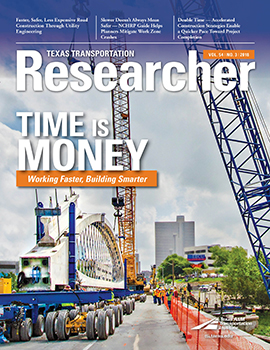
In 2018, the Texas Department of Transportation (TxDOT) published Accelerated Construction: A Path Forward. The document lays out a vision for implementing the principles of accelerated construction statewide. TxDOT emphasizes the need to educate and train personnel, but also recognizes that accelerated construction is about a lot more than just working faster and cheaper — it’s also about working smarter and safer. The department also issued its Accelerated Construction Guidelines that year.
I’m proud to say the Texas A&M Transportation Institute (TTI) helped the department formulate its approach to accelerated construction. TTI Executive Associate Director Jon Epps applied his decades of expertise in materials, pavements and construction to lead a series of seven workshops in 2017 that provided guidance to TxDOT personnel and private contractors about the practices, pitfalls and benefits of accelerated construction. Out of that effort came tools and recommended procedures to move the practice forward in Texas.
As you’ve seen in this issue of the Texas Transportation Researcher, any transportation construction project, particularly one fast-tracked to completion, is a complicated venture. Funding and planning, designing and securing right-of-way, environmental concerns, the impact of construction on the traveling public — the list of considerations is long. Avoiding costly delays is key to effectively managing a construction project, as well as the expenditure of taxpayer dollars. As transportation professionals, we have a fiduciary responsibility to maintain that public trust.
Accelerated construction can help us do that. In describing accelerated bridge construction (ABC), the Federal Highway Administration prioritizes mobility. For example, minimizing traffic disruption by prefabricating bridge elements easily assembled onsite is a fundamental principle of ABC. You read in this issue about the reconstruction of Fort Worth’s West 7th Street Bridge. TTI’s participation in the public-private partnership that formed the West 7th Street Bridge Coalition is one example of how outside-the-box thinking is getting things done for Texans.
On July 23, U.S. House Transportation and Infrastructure Committee Chairman Bill Shuster (R-Pa.) released a draft bill aimed at improving our nation’s infrastructure. The “discussion draft,” as Chairman Shuster calls it, is intended to kindle debate to find “real solutions that will give America the modern day infrastructure it needs.” Title IV of the bill addresses accelerated project delivery. From expedited decision-making to reducing permitting to a maximum of two years, streamlining the construction process is a primary goal of the bill.
Chairman Shuster’s plan is ambitious and, no doubt, will evolve through the legislative process. Its underlying purpose is to help counties facilitate the construction process locally. That’s also TxDOT’s goal with its new guidelines on accelerated construction. Local solutions guided by state expertise and supported by federal policy — now that’s the way to build a better, safer transportation system while being good stewards of not only taxpayer dollars, but also the public trust.

